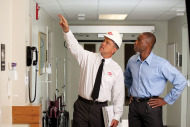Joint Commission adds new medication compounding chapter for certain facilities
The Joint Commission is implementing a new medication compounding standards chapter in its Comprehensive Accreditation Manual for Home Care. The requirements will apply to all compounding pharmacies seeking initial accreditation or triennial reaccreditation. The new chapter has been adapted from the Joint Commission’s Medication Compounding Certification requirements and aligns with current U.S. Pharmacopeial Convention requirements for sterile and nonsterile preparations.
The chapter sets environmental standards for airflow, buffer areas, cleaning and documentation, and storage. It also focuses on proper training for staff and product quality.
ASHE collecting health care facility energy and water survey data
The American Society for Healthcare Engineering is collecting data for the Energy and Water Survey, designed by the Environmental Protection Agency (EPA).
The EPA plans to use the data to help update Energy Star benchmarks. ASHE states that the responses will help to ensure that benchmarks accurately reflect the health care field and may provide the necessary data to recertify medical office buildings.
Respondents can earn up to 10 contact hours in continuing education credits for completing the survey.
Airborne pathogens can live for 45 minutes, study says
A new study shows that a common multidrug-resistant bacteriium can spread up to four meters and live in the air for 45 minutes.
Researchers at the Queensland University of Technology studied the longevity of airborne Pseudomonas aeruginosa bacteria, which is associated with health care-associated infections and expelled by coughs and sneezes. The researchers sampled cough droplets from two patients and found that when the droplets hit the air, they dried out and became cool and light enough to remain airborne while partly degrading through contact with oxygen. Much of the active bacteria showed rapid decay, but a subset showed resistance to rapid biological decay and could remain viable long enough to post an infection risk.
NIOSH examines respiratory protection options for health care workers
The National Institute for Occupational Safety and Health breaks down the differences between respiratory protective gear in a recent post written by one of its fellows.
Michael Bach, Ph.D., R.N., examines the differences between disposable N95 respirators and reusable options including elastomeric respirators and powered air-purifying respirators. Bach notes the benefits and downfalls commonly associated with each type, but notes that in times of high demand, such as during an outbreak, reusable respirators could be a viable alternative to common disposable options.
“Understanding the available types of respiratory protective devices and their correct use are important to the promotion of healthy working environments,” he writes. “Elastomeric respirator use is a practical option that may be considered for respiratory protection within health care institutions.”





